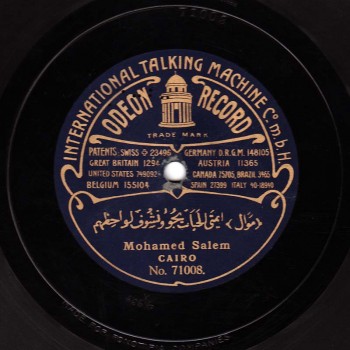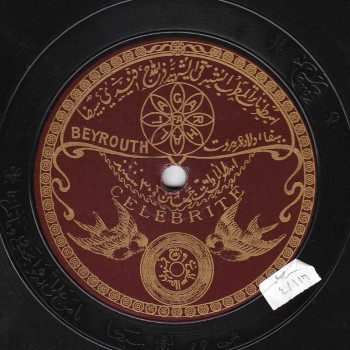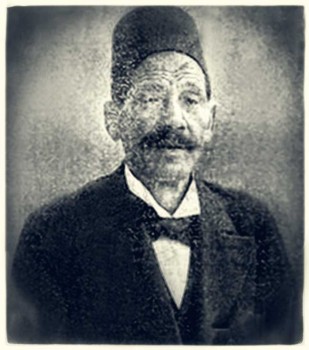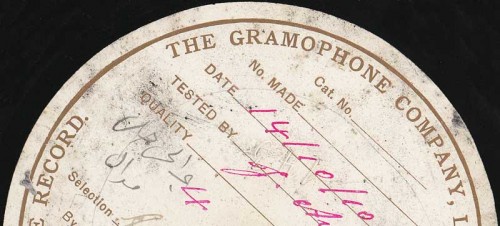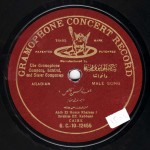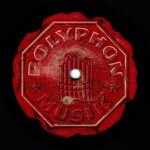The mawwāl is the third passage of the musical waṣla sang in classical Arabic during the Nahḍa period. It is preceded by the instrumental istihlāl (overture) represented by the samā‘ī or the bashraf, and the vocal istihlāl embodied by the muwashshaḥ. We can safely state that the mawwāl is the passage of taqsīm, layālī, and mawwāl, all being interconnected passages gathered under one appellation: the mawwāl. This passage is supposed to be entirely improvised to the same maqām as the waṣla’s maqām. The mawwāl started as a popular form before gradually entering the vocal waṣla. Various forms of mawāwīl are found in the popular traditions of the Arab people. This particular subject will be discussed in another episode. Today’s episode is about the mawwāl in the literary artistic traditions.
The mawwāl as a literary form is a text written in dialectical Arabic. Some trace it back to the word mawāliya. There are different forms of mawwāl, yet only two of them are left in the waṣla. These two forms are written to the baḥr al-basīṭ “mustaf‘ilun fā‘ilun mustaf‘ilun fā‘ilun”.
First, the 7 hemistiches’ mawwāl: This form is the least famous and least used, at least in the waṣla. It is divided into 2 types. The original type is the baghdādī written in refined colloquial Iraqi dialect or in a Damascene “white” dialect. It spread in Aleppo and throughout the Levant to a point where it is barely cited in its native country Iraq. The baghdādī is considered to be from the heart of the Damascene heritage. The rhyme of the first 3 hemistiches is the same, as is the rhyme of the following 3 hemistiches, both rhymes being different. The 7th hemistich follows the rhyme of the 3 first hemistiches. The rhyme is the word ending each hemistich. It is usually a word play, i.e. one word or one paragraph that may imply different meanings. The other types of mawwāl, as mentioned earlier, are sang mursala without a rhythmic cycle following a lyrics measured rhythm. Yet some baghdādī mawāwīl follow a rhythmic cycle. And even if the latter is totally unrelated to the singing, it seems to have something to do with the interaction with the listeners, i.e. attracting the listeners’ attention with a rhythmic cycle.
We will listen now to a baghdādī mawwāl following the above-mentioned pattern: “Yā man ‘alayya ad‘u bi-ḥ’ū’ī” to the sīkāh maqām by Farjallāh Bayḍā. This recording –one of Baidaphon’s first records- was made around 1906, on one side of a 30cm record, # 9 Z 3.
The second form of the 7 hemistiches’ mawwāl is the same as the first form except for the dialect. It is written in Egyptian dialect and is called nu‘mānī, whereas as some call it baghdādī. Anyway, the form is the same, but the melodic aspect is different. Unlike the Damascene form, the second form of mawwāl is not followed by a rhythmic cycle, not even to attract the listeners’ attention. We will now study the wordplay concept in detail: the mawwāl –of this form– we will listen to is a clear example of this concept. Its lyrics are as follows:
Amr el-gharām lī waṣal rabb el-gamāl māḍīh (the rhyme word “māḍīh” means “is past” or “signed it”)
We-el-ḥusni mahmā ṭalab minnī anā māḍīh (the rhyme word “māḍīh” means “māḍīn quḍuman fīhi” i.e. “went straight ahead and did it”)
Dā wagdi ḥālī tagaddad bi-el-anīn māḍīh (the rhyme word “māḍīh” means “what was in the past”)
Law kunti tisma‘ fī gunḥi el-lēl āhātī (4th hemistich. The rhyme has changed to “hātī”, starting with “āhātī “ that means “sighs”)
We-anā ba’ūl min lahībī Yā dmū‘ hātī (the rhyme word “hātī” means “give” i.e. “yā ‘aynu jūdī bi-el-da‘ ” meaning “my eye, go ahead and cry”)
La kunti tu‘dhur wa-lākin Ya ‘adhūl hātī (the rhyme word “hātī” –imperative verb in the Egyptian dialect- means “talk uselessly, to no avail”. He is saying: rebuker/critic, talk all you want, no one will listen to you)
Siḥr el-lawāḥidh fatak fī muhgitī māḍīh (7th hemistich. The rhyme changes back to the first rhyme “māḍīh”. The rhyme word “māḍīh” –here a metaphor, an idiom of “saber”– implies “māḍī al-ḥusām” i.e. “saber”)
Then let us listen to a nu‘mānī mawwāl “Amr el-gharām” performed by ‘Abd al-Ḥayy Afandī Ḥilmī to the bayyātī maqām, with murāsala and muḥāsaba performed by Muḥammad Afandī Ibrāhīm (qānūn). This is a rare unpublished recording made by Gramophone in 1910 on one side of a 30cm record, order #143Z.
Second, the 5 hemistiches’ mawwāl: This form is also divided into two types. The a‘raj type: the rhyme in the 5 hemistiches is the same except for the 4th hemistich ending with a different rhyme. It also includes wordplay –as shown previously–. We will listen to Muḥammad Sālim al-Kabīr performing the a‘raj mawwāl “Emtā el-ḥabāyib yigum we-nshūf lawāḥidhhum” recorded in 1904 by Odeon on one side of a 35cm record –the rarest record size with the longest duration, of course, since it was the largest size that was recorded with the duration of one side exceeding 5 minutes–, order # 71008, matrix # EXX 934 with ‘Abd al-‘Azīz al-Qabbānī (qānūn) and Sayyid al-Suwaysī (‘ūd) performing to the ḥijāz maqām. We ask our listeners to try to explain the rhyme in this mawwāl.
The second type of the 5 hemistiches’ mawwāl is the white mawwāl. In this context, white implies that the meaning is clear and does not include ambiguity or wordplay. This form had seemingly existed for very long time, yet it was considered the weakest. Still, it is the most widely spread since the 1930s. We must mention here an unprecedented style in mawwāl chanting. It is the setting of the melody. The desire to set the melody and to separate the composer from the performer has equally affected the fully improvised forms, the set-melody forms and the quasi-improvised forms. The example we are listening to clearly shows that the mawwāl’s melody is a set melody. It indicates a previous knowledge of the positions of the taqsīm, the murāsala and the muḥāsaba. It also shows the setting of the layālī preceding the mawwāl, their sequence and the sequence of the instruments that will conduct murāsala and translation (interpretation) vis-à-vis the performer, and the shrinking of the improvisation to a few instrumental taqāsīm and maybe some singing measures. We can venture and define this as a total cancellation of the improvisation. The mawwāl “Amāna yā lēl” illustrates all these points. It was written by Amīn ‘Izzat al-Hagīn, composed and sang by ‘Abd al-Wahāb playing the ‘ūd, accompanied by Muḥammad ‘Abduh Ṣāliḥ (qānūn), Jamīl ‘Oways (kamān) performing to the zanjarān maqām –a sub-maqām of the ḥijāz maqām. It was recorded by Baidaphon around 1932, # B-095420 and B-095421.
There is no doubt that there is a difference between the duration of the mawwāl in live performances and its duration in recordings. In the same context, performers undoubtedly benefitted from the recording technology. In the previous sample for example –and the same goes for most recordings of mawāwīl–, the passage of the taqsīm is layālī in the first wajh, then another instrument performs the overture of the second wajh with a taqsīm followed by the mawwāl. We can surely not imagine the performance of the mawwāl in live shows with the listeners and the interaction between them and the performers, or the interaction among the performers, or even that the mawwāl is not independent but included in the waṣla, i.e. that the maqām was fixed in the minds of the performers and the listeners, unlike the disc that records cut parts of the waṣla. We will listen now to mawwāl “Fīk nās yā lēl” –an example of a recording that is close to a live performance–. It is excerpted from a waṣla to the sīkāh maqām by Ṣāliḥ ‘Abd al-Ḥayy, with murāsala and muḥāsaba performed by Muḥammad ‘Abduh Ṣāliḥ (qānūn), and recorded at the Egyptian radio in the late 1940s.
We have reached the end of our episode about the mawwāl.
We will meet again in another episode of “Our Musical System”
This episode was brought to you by Muṣṭafa Sa‘īd.
- 221 – Zakariyya Ahmed – 12 (1/9/2022)
- 220 – Zakariyya Ahmed – 11 (1/9/2022)
- 219 – Zakariyya Ahmed – 10 (11/25/2021)
- 218 – Zakariyya Ahmed – 9 (10/26/2021)
- 217 – Zakariyya Ahmed – 8 (9/24/2021)
- 216 – Zakariyya Ahmed – 7 (9/4/2021)
- 215 – Zakariyya Ahmed – 6 (8/28/2021)
- 214 – Zakariyya Ahmed – 5 (8/6/2021)
- 213 – Zakariyya Ahmed – 4 (6/26/2021)
- 212 – Zakariyya Ahmed – 3 (5/27/2021)
- 211 – Zakariyya Ahmed – 2 (5/1/2021)
- 210 – Zakariyya Ahmed – 1 (4/28/2021)
- 209 – W-al-Lāhi lā astaṭī‘u ṣaddak 2 (4/6/2017)
- 208 – W-al-Lāhi lā astaṭī‘u ṣaddak 1 (3/30/2017)
- 207 – Bashraf qarah baṭāq 7 (3/23/2017)

